BRUCCIANI Domenico Giovanni 1814-1880
Their Children at this time are Maria Teresa, 1778-1847
Niccolao 1780
Luigi 1785-1848
Iacopo 1786-1854
Vincenzo,1790-1829
Pietro Antonio 1793-1881 and Giuseppe 1793-1875
At least three of the brothers had professions in the Plaster of Paris and Stucco . Domenico’s father was Vincenzo. His uncle who trained him in London was Luigi. And his brother Niccolas also had premises in London doing the same work.
Domenico Brucciani (1814-80)
Domenico was only one of our extended family members who were figurinai from Barga and who travelled Britain in the late eighteenth and early nineteenth centuries. Travelling in small groups, the Lucchesi walked across Europe to Britain, making and selling small plaster figures along the journey before returning to Italy for the winter. Domenico was my 1st cousin x 4 removed.
Domenico Brucciani was born in Castelvecchio [now Pascoli], Barga, Lucca, Italy in 1814. He arrived in London c 1829.
As early as 1829 he was trading from Little Russell Street, Kensington. He then established a Gallery of Casts in Covent Garden by 1837. In 1835 we find Domenico living at an address 13 Bucknall Street in Holborn, Finsbury, London
The 1841 census tells us he was living with his uncle Luigi and his occupation as a ‘Professor of Modelling in Clay’. His first wife was also with them.
The figure of the itinerant Italian ‘image seller’ became a compelling trope for nineteenth-century artists and writers. Arriving in London from Barga in around 1829, age only 14, Domenico Brucciani entered the modest plaster figure making business of his uncle Antonio Luigi ‘Lewis’ Brucciani (1789-1848) in Covent Garden.
Domenico’s Uncle Luigi Brucciani [1785-1848] was born in Barga and given the name Antonio Luigi Brucciani. Luigi left for London circa 1820 and was in business in Lambeth two years later. [This information given by Bruno Caproni who provided some of this information to Diane Currie in 2019]. Luigi’s wife Lucy took out insurance in 1824 in Trust for him as an Artificial Flower Manufacturer, then later the same year also as a Plaster Figure Maker. It was not until 1828 that Luigi set up his business in Drury Lane. By the time of the 1841 census he was living at 5 Little Russel Street as a Figure Maker age 55. With him on this census was his second wife Ann Miller, his nephew Dominic, also a figure maker age 25 born overseas and Mary age 20 British Born. Luigi retired to Barga in 1844 and died 4 years later.
Another of his uncle’s Nicolao [1780] had also travelled to London where he married Elizabeth Susanah Checkeni
BY 1847 Domenico had re-married to Eliza Sumner. From 1850 he was trading from 1 Leather Lane in partnership of Giovanni Graziani as Plaster Figure Makers, a business which he continued following the dissolution of their partnership in 1857.
The copying of art became a lucrative trade across Europe. Brucciani’s firm, which was one of the most successful, developed links with both the British Museum and the South Kensington Museum (now the Victoria & Albert Museum). Both institutions assembled important collection of casts of sculpture and architecture during this period. Domenico worked as a Modeller for the museum, taking casts of items in their collections and supplying other casts. He described himself as ‘Formatore’ or Maker and Modeller to the Science and Art Department, as well as to the British Museum and the Royal Academy of Arts.
Brucciani’s most ambitious undertaking was the casting of the Pórtico de la Gloria, the 12th-century façade of the cathedral at Santiago de Compostela, Spain, in 1866. The Cast Courts (then called the Architectural Courts) of the South Kensington Museum were specially designed to accommodate the 18-metre width of this enormous cast.
Domenico died at the age of 65 in 1880 leaving a personal Estate of under £4000. His Will recorded him as of 40 Russell Street, Covent Gardens, and 1 Leather Lane, This information given by Giuseppe Caproni, Modeller and Thomas Carr, Upholsterer, who were both executors in his Will. The Caproni and Brucciani families had ties back to Barga. Domenico’s business continued into the 20th century.
Taking over the business in the early 1840s, Domenico rapidly expanded the stock of classical and contemporary sculpture and architectural ornament and secured prestigious contracts to supply museums, art galleries and schools of art across Britain and later, North America, India and Australia..
Brucciani built a reputation for excellence and ingenuity and was often referred to as an artist, but he was chiefly a plasterman but always an artist at heart’. Unlike the figurinai who were associated with street hawking, low quality casts and petty criminality, Brucciani used plaster as a mechanism for social mobility and assimilation, building a business that would become so crucial to the cultural life of the country that it was effectively nationalised after his death.
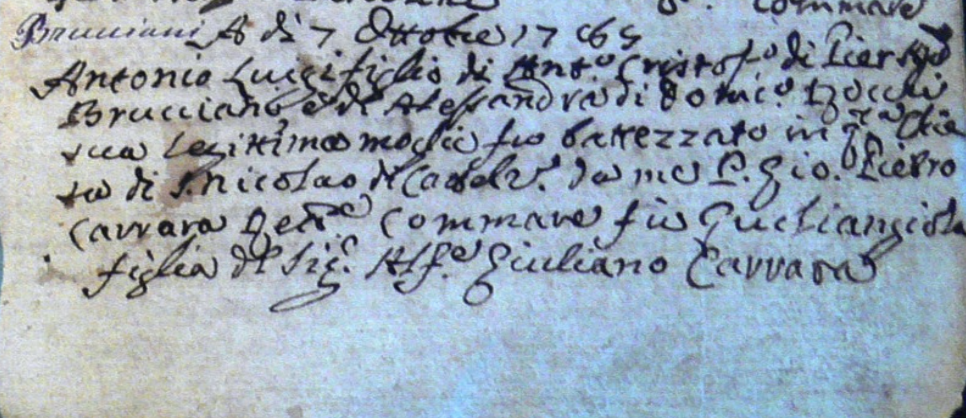
Domenico’s uncle Luigi’s birth
The early history of the Brucciani family as Italian figure makers in London requires elucidation. Lewis Brucciani was in business in Lambeth as early as 1822. His wife Lucy Brucciani (d.1838) took out insurance in 1824 in trust for him as an artificial flower manufacturer, and later the same year also as a plaster figure maker, but it was not until 1828 that Lewis Brucciani set up in business in Drury Lane. Domenico Brucciani eventually took over this business but not before he had traded independently elsewhere (see below). Domenico was presumably Lewis and Lucy Brucciani’s son, but it is not clear how he relates to another figure maker, Nicholas or Nicolao Brucciani, found at 24 Wellington Terrace, Waterloo Road from 1839 to 1843, whose age was given as 60 in the 1841 census. Two further Italian plaster figure makers by the name of Brucciani, both born at Barga, close to Lucca, were recorded in the 1881 census in Camberwell, Raffaele, age 24, and Pietro, age 19.
Domenico Brucciani (c.1815-1880) is said to have been born in Lucca in 1815. He married Mary Ann Richardson in 1841 at St Martin-in-the-Fields, apparently remarrying, as Domenico Giovanni Brucciani, in 1846 at Richmond. He traded from Little Russell St from 1829. He also traded from 1 Leather Lane in partnership with Giovanni Graziani as plaster figure makers, a business which he continued following the dissolution of the partnership in 1857 (London Gazette 20 March 1857). When Brucciani’s new premises, the Galleria delle Belle Arti, opened at 40 Russell St in 1864, the size of his new gallery of casts was given as 100 by 25 feet (Art Journal, vol.3, 1864, p.330). He worked as a modeller for the South Kensington Museum (now the Victoria and Albert Museum) and the British Museum, taking casts of items in their collections and supplying other casts. He described himself as ‘Formatore [i.e., maker] & Modeller to the Science and Art Department’, as well as to the British Museum and the Royal Academy of Arts, on his handsome blue invoice paper (examples from 1870s, National Portrait Gallery records, Duplicates of Accounts, vol.1, pp.71-3, 104).
Following Brucciani’s death at the age of 65 in 1880, his business and stock-in-trade were advertised for sale (The Times 26 May 1880). By 1891, an individual by the name of Caproni was trading as D. Brucciani & Co (The Times 10 December 1891). He would appear to be Joseph L. Caproni (1846-1900), who was recorded in the 1881 census at 148 Grays Inn Road as a plaster moulder (arts), age 34, born in Italy but living in London since at least 1868, when his eldest son was born. There were subsequent close connections between the Caproni and Brucciani families, as is apparent from the record of the birth in 1926 of Enrico Brucciani to a mother by the maiden name of Caproni.
By the time of the First World War, as the demand for plaster casts declined, the Brucciani business was finding it increasingly difficult to carry on, as was reported in 1916 (The Times 26 December 1916). In response to the threat that their unique collection of plaster moulds and casts might be dispersed, a petition led by Sir Edward Poynter PRA, that the Government should purchase the collection, was addressed to the Prime Minister but without success. The shipowner, Sir William Petersen, then supplied the means for the business to carry on during the war. The business went into liquidation in 1921, when a meeting of the company was held at the Victoria and Albert Museum (London Gazette 15 July 1921). The company was taken over by the Board of Education and run by the Victoria and Albert as a museum service, renamed the Department for the Sale of Casts, until financial losses forced its closure in 1951.
Brucciani’s most important commission for the South Kensington Museum, according to the Victoria and Albert Museum website, was the casting of the 12th-century Portico de la Gloria, an 18-metre wide section of the façade of the cathedral at Santiago de Compostela, undertaken in 1866. The National Portrait Gallery owns 24 electrotypes and works in plaster cast by Brucciani, the electrotypes commissioned by the Gallery between 1869 and 1877 from Elkington & Co from casts made by Brucciani, and the plasters acquired from various sources between 1878 and 1911.
Domenico Brucciani (1815-1880)
Artist associated with 23 portraits
Plaster figure maker. Born near Lucca, Italy, Brucciani came to England with his uncle. . He established a Gallery of Casts in Covent Garden and became the leading figure maker in London. He worked for the South Kensington Museum (now the Victoria and Albert Museum), the British Museum and the National Portrait Gallery, taking casts of items in their collections and of monuments elsewhere..
This insert was posted to Ancestry.com
Lewis Brucciani 1822-1844, Domenico Brucciani 1846-1881, D. Brucciani & Co 1882-1906, D. Brucciani & Co Ltd 1906-1921. At Lower Lambeth Marsh, London 1822-1824, 15 Denton St, Somers Town 1824, 9 Winchester St, Pentonville 1827-1828, 131 Drury Lane 1828, 5 Little Russell St 1829-1860, 1 Leather Lane 1857-1880, 58 Baker St 1853, 5, 6, 7 and 8 Little Russell St 1858-1860, street renamed and renumbered 1860/1, 36 and 39 Russell St 1862-1864, Galleria delle Belle Arti, 40 Russell St WC 1864-1901, 13 Bucknall St 1895-1901, 254, 256, 258 Goswell Road, EC 1902-1921. Figure maker 1822, Plaster figure man 1841, Formatore and modeller 1870s.
Following Brucciani’s death at the age of 65 in 1880, his business and stock-in-trade were advertised for sale (The Times 26 May 1880). By 1891, an individual by the name of Caproni was trading as D. Brucciani & Co (The Times 10 December 1891). He would appear to be Joseph L. Caproni (1846-1900), who was recorded in the 1881 census at 148 Grays Inn Road as a plaster moulder (arts), age 34, born in Italy but living in London since at least 1868, when his eldest son was born. There were subsequent close connections between the Caproni and Brucciani families, as is apparent from the record of the birth in 1926 of Enrico Brucciani to a mother by the maiden name of Caproni
By the time of the First World War, as the demand for plaster casts declined, the Brucciani business was finding it increasingly difficult to carry on, as was reported in 1916 (The Times 26 December 1916). In response to the threat that their unique collection of plaster moulds and casts might be dispersed, a petition led by Sir Edward Poynter PRA, that the Government should purchase the collection, was addressed to the Prime Minister but without success. The shipowner, Sir William Petersen, then supplied the means for the business to carry on during the war. The business went into liquidation in 1921, when a meeting of the company was held at the Victoria and Albert Museum (London Gazette 15 July 1921). The company was taken over by the Board of Education and run by the Victoria and Albert as a museum service, renamed the Department for the Sale of Casts, until financial losses forced its closure in 1951.
The business’s products and activities: The nature of Domenico Brucciani’s stock can be traced from their trade catalogues (V&A National Art Library). A catalogue of casts, from 5 Little Russell St, thus probably dating to the 1840s or 1850s, claimed to offer the largest collection in Europe of antique and modern statuary, Greek, Roman and mediaeval ornament, ‘to be viewed gratis’. Brucciani claimed to have extended his stock by importing from Rome, Paris etc a large assortment of the best works of modern artists. These included casts of works by Thorwaldsen, Canova, Sir Richard Westmacott, Baily, Gibson, and Flaxman (Catalogue of Casts for sale by D. Brucciani, n.d., 50pp, plus Catalogue of Casts from Mediaeval Art, 37.R Box XI). A catalogue from 40 Russell St, thus dating to the 1860s or 1870s, offered a similar range, also advertising that subjects could be supplied in artificial stone for gardens and parks (Catalogue of Reproductions of Antique and Modern Sculpture, 56pp, 37.X.60, as [1864]).
Brucciani’s most important commission for the South Kensington Museum, according to the Victoria and Albert Museum website, was the casting of the 12th-century Portico de la Gloria, an 18-metre wide section of the façade of the cathedral at Santiago de Compostela, undertaken in 1866. The National Portrait Gallery owns 24 electrotypes and works in plaster cast by Brucciani, the electrotypes commissioned by the Gallery between 1869 and 1877 from Elkington & Co from casts made by Brucciani, and the plasters acquired from various sources between 1878 and 1911.
Brucciani’s most important commission for the South Kensington Museum, according to the Victoria and Albert Museum website, was the casting of the 12th-century Portico de la Gloria, an 18-metre wide section of the façade of the cathedral at Santiago de Compostela, undertaken in 1866. The National Portrait Gallery owns 24 electrotypes and works in plaster cast by Brucciani, the electrotypes commissioned by the Gallery between 1869 and 1877 from Elkington & Co from casts made by Brucciani, and the plasters acquired from various sources between 1878 and 1911.
The business also treated sculpture. D. Brucciani & Co Ltd worked for the National Portrait Gallery, 1912-20, mainly on plaster busts, for example, cleaning and colouring six plaster casts by Woolner for £3.3s in 1912, ‘Removing old paint & colouring Black Bronze’ George Gammon Adams’s Sir Charles Napier for £2.2s in 1914, and treating in a similar manner 33 plaster casts for £52.16s in 1915 (Duplicates of Accounts, vol.7, pp.79, 112, 134, 150, vol.8, p.42). Subsequently, the Victoria and Albert Museum, as successors to Brucciani, undertook somewhat similar work for the National Portrait Gallery, including for example repairing Rysbrack’s terracotta, Sir Robert Walpole, for £5 in 1926 (Duplicates of Accounts, vol.9, p.57).
Sources: Francis Haskell and Nicholas Penny, Taste and the Antique: The Lure of Classical Sculpture 1500-1900, 1981, pp.117-8, 121-3 (for the supply of casts after the antique); Guildhall Library: Records of Sun Fire Office, vols 496 no.1019230, 500 no.1019514, 512 no.1063656, 518 no.1094287, 519 no.1084751, 527 no.1109487, 530 no.1125769, 544 no.1184057, 550 no.1208380; National Archives, Treasury: Treasury Board Papers and In-Letters, T 1/12516, for records relating to the Board of Education’s acquisition of the business, 1920; National Archives, Department of Education and Science and predecessors: Establishment Files ED 23/540, for records, 1919-34, on taking over the business and its subsequent reorganisation.
DOMENICO’S daughter Mary married Arthur C. Ryan. They had several children
PAUL JOSEPH RYAN 1867 – he followed on in the family business
MONICA MARIA BRUCCIANI RYAN 1868-1949. She remained a spinster and took on the parental duties of the rest of the family
WILFRED BRUCCIANI RYAN 1873
DOMINIC RYAN 1873
GERTRUDE MARIA BRUCCIANI RYAN 1875
AUSTIN BRUCCIANI RYAN 1879
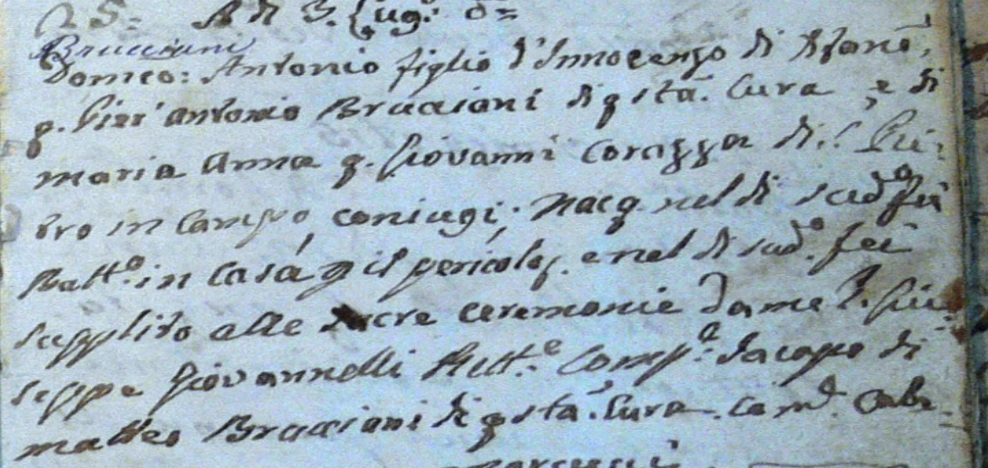
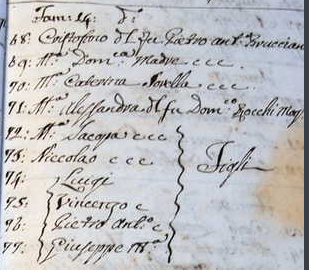




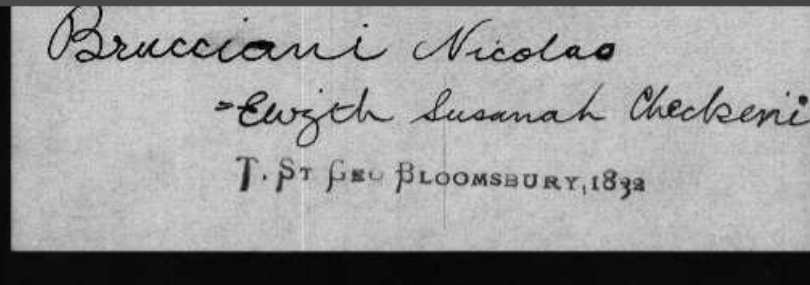
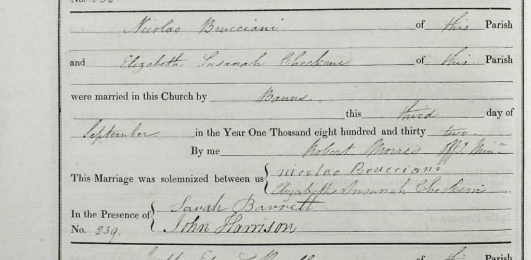
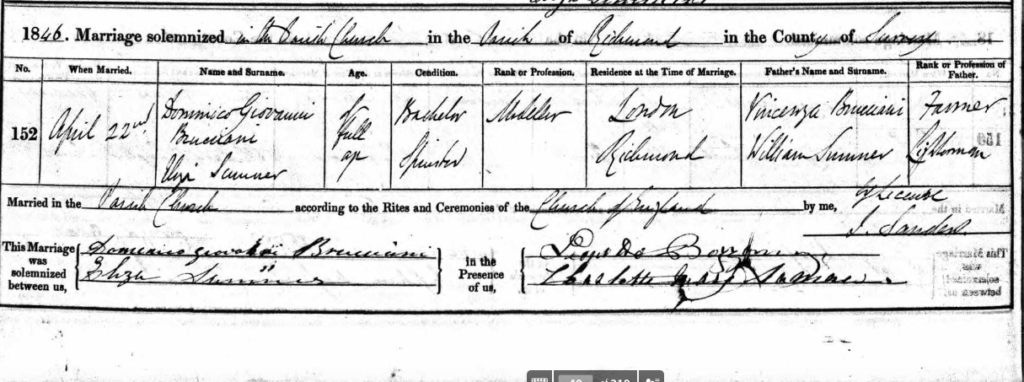
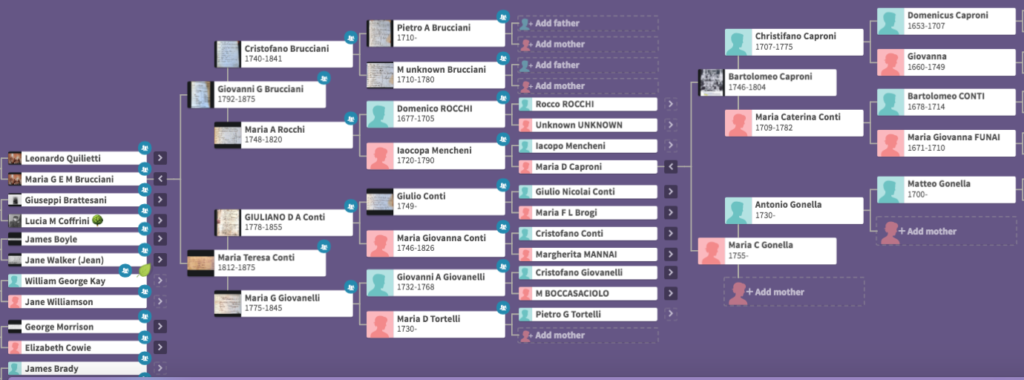

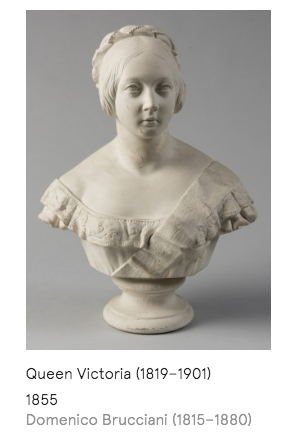



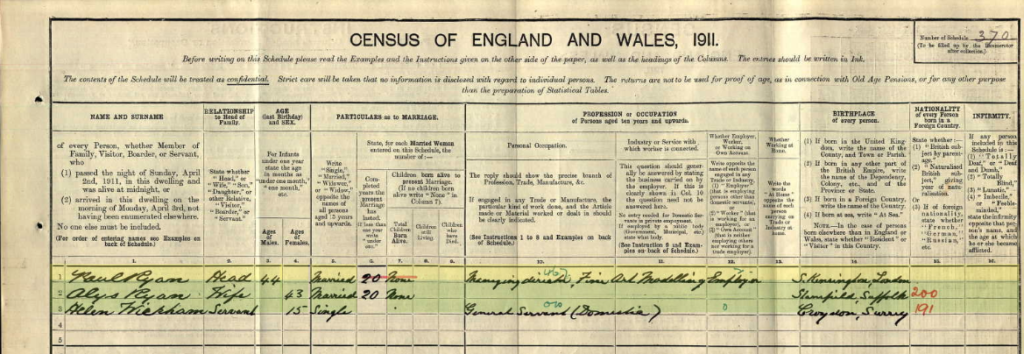
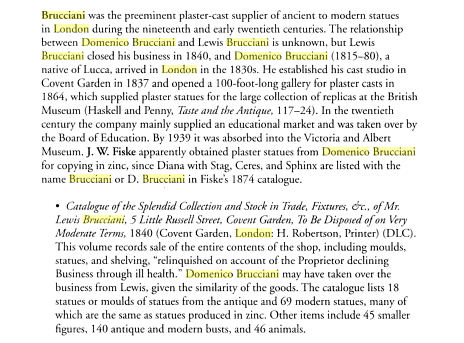
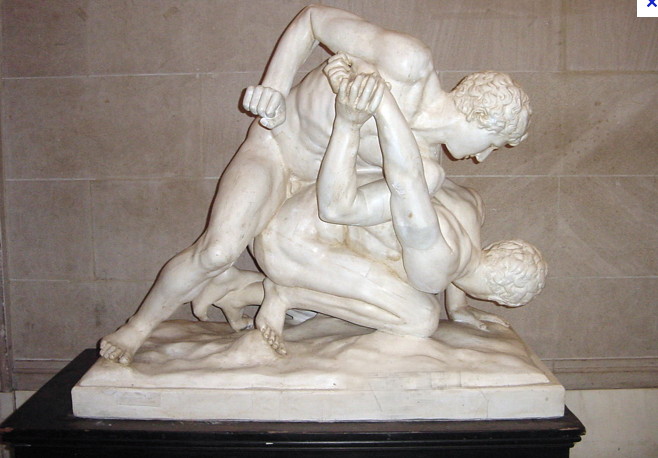
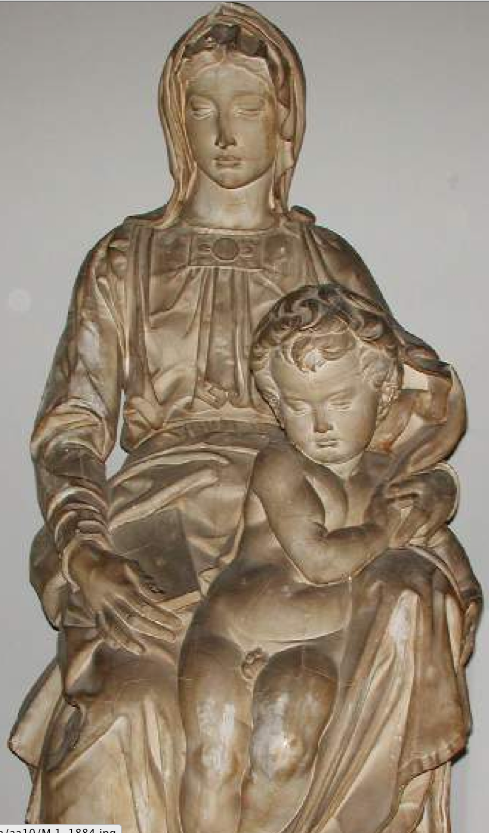
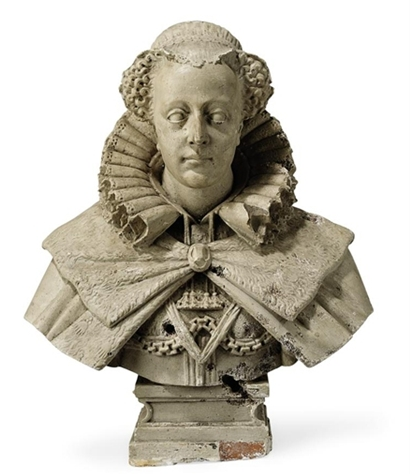

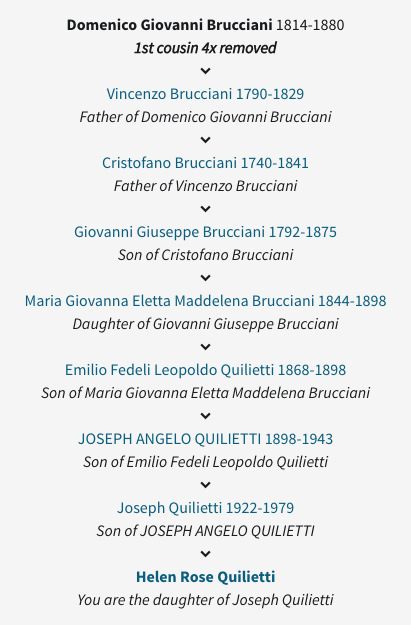
Hi, We have Elizabeth Susannah Checkeni in our tree and thought you may want to know what happened to them. Elizabeth was the dtr of Charles Dunn a Naval surgeon living at 65 Fleet Market b. 1787. After her marriage to Nicholas Brucciani they emigrated to NY in 1843 on the ship Quebec following her son Dominico and wife. She had married John Frederic Checkeni in 1804, a plaster of paris figure maker living in 3 Gilspur street. Two of their sons joined the union army. The Checkenis knew the Bruccianis through their trade ( see old Baily court sessions). Nicholas died NY 30 March 1850 Brookland b. 1780 , married 3 Sept 1832. Hope this fills in. Vaughan Cullen
I was just wondering, do we know the names and dates of dominico’s children… if he had any.